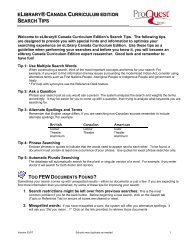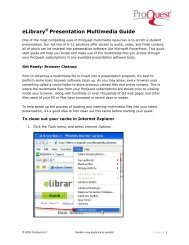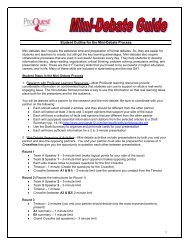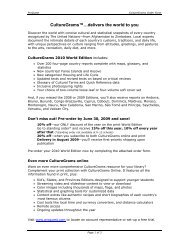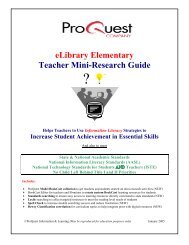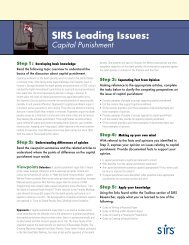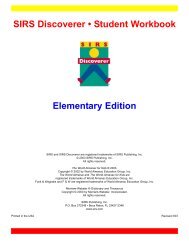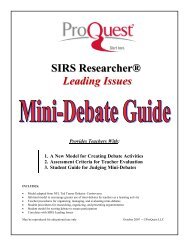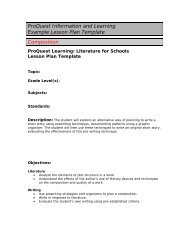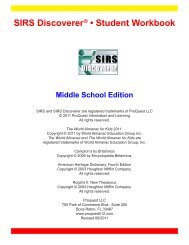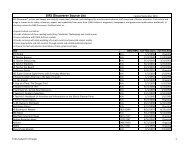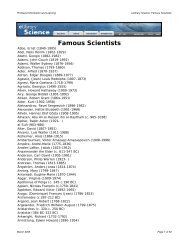New York City Schools and CultureGrams Standards ... - ProQuest
New York City Schools and CultureGrams Standards ... - ProQuest
New York City Schools and CultureGrams Standards ... - ProQuest
Create successful ePaper yourself
Turn your PDF publications into a flip-book with our unique Google optimized e-Paper software.
<strong>New</strong> <strong>York</strong> <strong>City</strong> <strong>Schools</strong> <strong>and</strong> <strong>CultureGrams</strong> St<strong>and</strong>ards-Based Curriculum Activities<br />
1. Civics-Government—Comparing Governments around the World with the U.S.<br />
(Especially appropriate for the annual Constitution Day in September)<br />
<strong>New</strong> <strong>York</strong> St<strong>and</strong>ard for Civics, Citizenship, <strong>and</strong> Government: St<strong>and</strong>ard 5.1--compare<br />
various political systems with that of the United States in terms of ideology, structure,<br />
function, institutions, decision-making processes, citizenship roles, <strong>and</strong> political culture; <strong>and</strong><br />
identify <strong>and</strong> analyze advantages <strong>and</strong> disadvantages of various governmental systems.<br />
<strong>New</strong> <strong>York</strong> St<strong>and</strong>ard for English Language Arts: St<strong>and</strong>ard 1: Students will read, write,<br />
listen, <strong>and</strong> speak for information <strong>and</strong> underst<strong>and</strong>ing. As listeners <strong>and</strong> readers, students will<br />
collect data, facts, <strong>and</strong> ideas; discover relationships, concepts, <strong>and</strong> generalizations; <strong>and</strong> use<br />
knowledge generated from oral, written, <strong>and</strong> electronically produced texts.<br />
<strong>CultureGrams</strong> Background: Governments take many different forms. Some are<br />
democratic, provide for civil liberties, <strong>and</strong> place an emphasis on individual choice. Other<br />
governments are controlled by a small group or single leader. How a country is governed<br />
affects everything from economy to religion.<br />
Activity: Using the <strong>CultureGrams</strong> World Edition, ask students to identify different types of<br />
governments found across the world. Discuss possible benefits <strong>and</strong> drawbacks of each type<br />
of system. For example: United States, Nigeria, or India—democratic republics; United<br />
Kingdom, Sweden, Thail<strong>and</strong>—constitutional monarchies; Laos, Cuba, or China—one-party<br />
totalitarian states; Turkmenistan, Zimbabwe—dictatorships; Swazil<strong>and</strong>, Saudi Arabia—<br />
monarchies. What impact does government type have on other parts of the culture? For<br />
example, have students read a report for Vietnam (one-party state), Myanmar (military<br />
regime), or Libya (one-party dictatorship) to see how the government influences its people<br />
in categories such as General Attitudes, Religion, Economy, Communications, <strong>and</strong><br />
Education.<br />
2. Geography—Comparing States Using a Variety of Factors<br />
Mathematics—Statistical Analysis<br />
<strong>New</strong> <strong>York</strong> St<strong>and</strong>ard for Geography: 1.Identify <strong>and</strong> compare the physical, human, <strong>and</strong><br />
cultural<br />
characteristics of different regions <strong>and</strong> people.<br />
<strong>New</strong> <strong>York</strong> St<strong>and</strong>ard for Mathematics: Representation Str<strong>and</strong>-- Students will select, apply,<br />
<strong>and</strong> translate among mathematical representations to solve problems (Use physical objects,<br />
drawings, charts, tables, graphs, symbols, equations, or objects created using technology as<br />
representations).<br />
<strong>New</strong> <strong>York</strong> St<strong>and</strong>ard for English Language Arts: St<strong>and</strong>ard 1: Students will read, write,<br />
listen, <strong>and</strong> speak for information <strong>and</strong> underst<strong>and</strong>ing. As listeners <strong>and</strong> readers, students will<br />
collect data, facts, <strong>and</strong> ideas; discover relationships, concepts, <strong>and</strong> generalizations; <strong>and</strong> use<br />
knowledge generated from oral, written, <strong>and</strong> electronically produced texts.<br />
<strong>CultureGrams</strong> Background: How does your state stack up against all the others? Is the<br />
population better educated than most? Younger? More bilingual? How ethnically diverse is it?<br />
1
Activity: Have your students access the Create-Your-Own-Tables feature in the <strong>CultureGrams</strong><br />
States Edition http://online.culturegrams.com/secure/states/create-your-own_tables.php.<br />
For the states, have them ―Add All.‖ For the categories, you can also have them ―Add All,‖ or<br />
you may designate certain selections for them. Once they click ―Create Comparison Table‖ a<br />
sortable table appears in a separate window. Clicking a category heading once ranks the<br />
category from lowest to highest; clicking the heading again ranks highest to lowest. Use this<br />
feature to have students discover where your state compares to the rest. What results did they<br />
expect? Were any surprising?<br />
3. World History—The Berlin Wall <strong>and</strong> the Contrast of Political Systems<br />
<strong>New</strong> <strong>York</strong> St<strong>and</strong>ard for World History: St<strong>and</strong>ard 4: analyze different interpretations of<br />
important events, issues, or developments in world history by studying the social, political,<br />
<strong>and</strong> economic context in which they were developed.<br />
<strong>New</strong> <strong>York</strong> St<strong>and</strong>ard for English Language Arts: St<strong>and</strong>ard 1: Students will read, write,<br />
listen, <strong>and</strong> speak for information <strong>and</strong> underst<strong>and</strong>ing. As listeners <strong>and</strong> readers, students will<br />
collect data, facts, <strong>and</strong> ideas; discover relationships, concepts, <strong>and</strong> generalizations; <strong>and</strong> use<br />
knowledge generated from oral, written, <strong>and</strong> electronically produced texts.<br />
<strong>CultureGrams</strong> Background: On August 13, 1961 the East <strong>and</strong> West sectors of Berlin were<br />
divided by a barbed wire fence (the Berlin Wall), which was soon replaced with a concrete<br />
wall. Ask students to read the History section of the <strong>CultureGrams</strong> World Edition Germany<br />
report<br />
http://online.culturegrams.com/world/world_country.php?contid=5&wmn=Europe&cid=60&<br />
cn=Germany. Also, show students the picture entitled ―Berlin Wall Crosses‖ from the<br />
<strong>CultureGrams</strong> Germany Photo Gallery<br />
http://online.culturegrams.com/gallery/albumindex.php?id=51&index=1&refername=Europ<br />
e&referid=4.<br />
Activity: Using these as background, discuss in greater detail how the post–World War II<br />
division of Germany led to the creation of an East German socialist state <strong>and</strong> the<br />
construction of the Berlin Wall.<br />
Ask the students to read the remainder of the <strong>CultureGrams</strong> report, making note of all<br />
instances where differences between Germans from the former East <strong>and</strong> the former West<br />
are discussed (e.g. in General Attitudes, tensions between people in the west <strong>and</strong> east<br />
exist; in Family, both parents are more likely to work in the east; in Economy, living<br />
st<strong>and</strong>ards in the east are lower, etc.) Use this reading to underscore the concept of the<br />
Mauer im Kopf (the Wall in the Head)—the idea that even though the Berlin Wall no longer<br />
exists, divisions remain between people in the west <strong>and</strong> east. Also introduce the<br />
controversial phenomenon known as Ostalgie, or nostalgia for the Ost (East).<br />
In a brief essay, have students summarize the differences they found between east <strong>and</strong><br />
west <strong>and</strong> respond to the following questions:<br />
1. What impact did the division between east <strong>and</strong> west have on German society, both in<br />
the past <strong>and</strong> now in the present?<br />
2. How would people have felt when the Wall fell <strong>and</strong> Germany was reunited?<br />
3. Why might people today think fondly of the former East Germany?<br />
4. Why would nostalgia for East Germany be controversial?<br />
2
4. Health Education—Disease Prevention <strong>and</strong> Control<br />
<strong>New</strong> <strong>York</strong> St<strong>and</strong>ard for Health Education: St<strong>and</strong>ard 3.1--Students will underst<strong>and</strong> the<br />
influence of culture,<br />
media, <strong>and</strong> technology in making decisions about personal <strong>and</strong> community health issues. They<br />
will know<br />
about <strong>and</strong> use valid health information, products, <strong>and</strong> services. Students will advocate for<br />
healthy families<br />
<strong>and</strong> communities.<br />
<strong>New</strong> <strong>York</strong> St<strong>and</strong>ard for English Language Arts: St<strong>and</strong>ard 1: Students will read, write,<br />
listen, <strong>and</strong> speak for information <strong>and</strong> underst<strong>and</strong>ing. As listeners <strong>and</strong> readers, students will<br />
collect data, facts, <strong>and</strong> ideas; discover relationships, concepts, <strong>and</strong> generalizations; <strong>and</strong> use<br />
knowledge generated from oral, written, <strong>and</strong> electronically produced texts.<br />
<strong>CultureGrams</strong> Background: Health <strong>and</strong> fitness can be affected by a variety of forces,<br />
including environment, diet, living conditions, literacy, <strong>and</strong> access to health care. Teach the<br />
students the difference between communicable <strong>and</strong> non-communicable diseases <strong>and</strong> discuss<br />
which of the above forces might contribute to each.<br />
Activity: Using the <strong>CultureGrams</strong> World Edition, assign students to read the following sections<br />
in a variety of reports: L<strong>and</strong> <strong>and</strong> Climate, Diet, Recreation, Education, <strong>and</strong> Health. Choose an<br />
example or two of communicable <strong>and</strong> non-communicable diseases (i.e. heart disease, cancer,<br />
obesity <strong>and</strong> AIDS, Malaria, Tuberculosis) <strong>and</strong> discuss them in light of the country sections you<br />
assigned. What cultural forces contribute to the development of both communicable <strong>and</strong> noncommunicable<br />
diseases in these countries? How could they be prevented <strong>and</strong> what holds people<br />
back from implementing these changes?<br />
As a class, decide on one way students might be able to help fight disease in another country.<br />
Ideas might include donating money as a class to a health-related charity, collecting scarce<br />
medical supplies <strong>and</strong> sending them to a hospital in the class’s country of choice, etc.<br />
5. Economics—Statistical Comparison of Countries’ Demographics<br />
Mathematics—Data Analysis<br />
<strong>New</strong> <strong>York</strong> St<strong>and</strong>ard for Economics: St<strong>and</strong>ard 2--Use economic information to identify<br />
similarities <strong>and</strong><br />
Differences to determine trends; infer relationships between various elements of an economy;<br />
organize <strong>and</strong><br />
present information in charts, tables, <strong>and</strong> graphs; extrapolate <strong>and</strong> make conclusions about<br />
economic<br />
questions, issues, <strong>and</strong> problems.<br />
<strong>New</strong> <strong>York</strong> St<strong>and</strong>ard for Mathematics: Representation Str<strong>and</strong>-- Students will select, apply,<br />
<strong>and</strong> translate among mathematical representations to solve problems (Use physical objects,<br />
drawings, charts, tables, graphs, symbols, equations, or objects created using technology as<br />
representations).<br />
<strong>New</strong> <strong>York</strong> St<strong>and</strong>ard for English Language Arts: St<strong>and</strong>ard 1: Students will read, write,<br />
listen, <strong>and</strong> speak for information <strong>and</strong> underst<strong>and</strong>ing. As listeners <strong>and</strong> readers, students will<br />
collect data, facts, <strong>and</strong> ideas; discover relationships, concepts, <strong>and</strong> generalizations; <strong>and</strong> use<br />
knowledge generated from oral, written, <strong>and</strong> electronically produced texts.<br />
3
<strong>CultureGrams</strong> Background: Sierra Leone’s real GDP per capita is $470, while Luxembourg’s<br />
is $53,780. Ten per 1,000 infants die yearly in American Samoa compared to 77 in Pakistan.<br />
Statistics, though they don’t tell the whole story about a country, offer helpful tools for tracking<br />
demographic <strong>and</strong> economic trends while comparing countries <strong>and</strong> regions.<br />
Activity: Choose a pair of statistics such as population <strong>and</strong> Real GDP per capita or literacy <strong>and</strong><br />
life expectancy. Using the <strong>CultureGrams</strong> World Edition, look up these statistics for five countries<br />
in some of the world’s major regions (Europe, Africa, North America, Caribbean, South America,<br />
Asia, Oceania, etc.).<br />
1. Create averages from the statistics found in the five <strong>CultureGrams</strong> for each region.<br />
2. Have students draw three histograms. The first should be a comparison of, for example,<br />
regional literacy averages; the second, regional life expectancy rates; <strong>and</strong> the third, a<br />
combination of both statistical averages.<br />
3. Compare <strong>and</strong> contrast the first two histograms. Do they share a similar pattern?<br />
4. Discuss the third histogram. Does there seem to be any correlation between the two<br />
statistics you analyzed? If so, what might be the cause of such a relationship? Might it<br />
be mostly coincidental, <strong>and</strong> if so, what other factors might affect the statistics you<br />
chose?<br />
For a more in-depth comparison, students could create a scatterplot, identify <strong>and</strong> eliminate<br />
countries that are extreme outliers, <strong>and</strong> recalculate the regional averages.<br />
6. Economics—Hispanics, NAFTA, <strong>and</strong> American Immigrant Labor<br />
U.S. History—National Hispanic Heritage Month<br />
<strong>New</strong> <strong>York</strong> St<strong>and</strong>ard for Economics: St<strong>and</strong>ard 1-- explain how economic decision making<br />
has become<br />
global as a result of an interdependent world economy.<br />
<strong>New</strong> <strong>York</strong> St<strong>and</strong>ard for U.S. <strong>and</strong> <strong>New</strong> <strong>York</strong> History: St<strong>and</strong>ard 2-- analyze the role<br />
played by the United States in international politics, past <strong>and</strong> present.<br />
<strong>New</strong> <strong>York</strong> St<strong>and</strong>ard for English Language Arts: St<strong>and</strong>ard 1: Students will read, write,<br />
listen, <strong>and</strong> speak for information <strong>and</strong> underst<strong>and</strong>ing. As listeners <strong>and</strong> readers, students will<br />
collect data, facts, <strong>and</strong> ideas; discover relationships, concepts, <strong>and</strong> generalizations; <strong>and</strong> use<br />
knowledge generated from oral, written, <strong>and</strong> electronically produced texts.<br />
<strong>CultureGrams</strong> Background: Each year we celebrate National Hispanic Heritage Month in<br />
September, when the culture <strong>and</strong> contributions of Hispanic Americans are recognized. This day<br />
marks the independence day of Guatemala, El Salvador, Honduras, Nicaragua, <strong>and</strong> Costa Rica.<br />
Mexico’s Independence Day is the next day, on September 16. Help students gain a better<br />
underst<strong>and</strong>ing of issues facing Mexico <strong>and</strong> the U.S. Hispanic community.<br />
Activity: Begin by student study of the picture entitled ―Hotels in Cancún‖ in the Mexico photo<br />
gallery at<br />
http://online.culturegrams.com/gallery/index.php?id=23&refername=The%20Americas&referid<br />
=3] from the <strong>CultureGrams</strong> Online World Edition<br />
[http://online.culturegrams.com/world/index.php]. Read the caption out loud <strong>and</strong> discuss the<br />
ways in which the United States takes advantage of <strong>and</strong> benefits from the cheap labor that<br />
Mexico provides. Next, in order to give students an image of what life is like for many Mexicans,<br />
display the following pictures: ―Boys Fishing,‖ ―Children Eating Tortillas,‖ ―Making Masa,‖<br />
4
―Making Tamales,‖ ―Schoolchildren,‖ <strong>and</strong> ―Rustic Stove.‖ Discuss why Mexicn people, like those<br />
from the pictures, might be attracted to work in U.S. factories on the Mexican border, even<br />
though they get paid much less than their U.S. American counterparts would for doing the<br />
same work.<br />
Introduce NAFTA (North American Free Trade Agreement) by reading the Economy section of<br />
the Mexico <strong>CultureGrams</strong> report as a class. Provide more details as you think necessary,<br />
outlining both the pros (increased jobs with higher-than-average wages for Mexicans, increased<br />
profits for U.S. companies, etc.) <strong>and</strong> the cons (U.S. jobs exported to Mexico, unsafe or<br />
unregulated working conditions in maquiladoras [manufacturing plants], underpaid Mexican<br />
workers, etc.).<br />
Move the desks into a fishbowl formation (one small circle in the center of the room surrounded<br />
by a much larger one outside it.) Ask for three or four volunteers to sit in the center. The rules<br />
for the fishbowl are that only the students in the center may speak; those on the outside circle<br />
must tap the shoulder of a student on the inside circle to trade places; <strong>and</strong> everyone must<br />
participate. To motivate students to join in, place a c<strong>and</strong>y bowl in the center of the inner circle<br />
or award points for participation. Students in the center begin their discussion by drawing from<br />
a bowl of questions you have already prepared on the economic, cultural, <strong>and</strong> ethical<br />
ramifications of the use of cheap Mexican labor in relation to NAFTA <strong>and</strong> immigration (illegal or<br />
otherwise). When the discussion dies down, students pick another question from the bowl <strong>and</strong><br />
continue.<br />
7. Science--Environmental—Greenhouse Effect <strong>and</strong> Air Pollution<br />
Mathematics—Data Analysis<br />
<strong>New</strong> <strong>York</strong> St<strong>and</strong>ard for Science—The Living Environment: St<strong>and</strong>ard 7--Human<br />
decisions <strong>and</strong> activities have had a profound impact on the physical <strong>and</strong> living environment.<br />
<strong>New</strong> <strong>York</strong> St<strong>and</strong>ard for Mathematics: Representation Str<strong>and</strong>-- Students will select, apply,<br />
<strong>and</strong> translate among mathematical representations to solve problems (Use physical objects,<br />
drawings, charts, tables, graphs, symbols, equations, or objects created using technology as<br />
representations).<br />
<strong>New</strong> <strong>York</strong> St<strong>and</strong>ard for English Language Arts: St<strong>and</strong>ard 1: Students will read, write,<br />
listen, <strong>and</strong> speak for information <strong>and</strong> underst<strong>and</strong>ing. As listeners <strong>and</strong> readers, students will<br />
collect data, facts, <strong>and</strong> ideas; discover relationships, concepts, <strong>and</strong> generalizations; <strong>and</strong> use<br />
knowledge generated from oral, written, <strong>and</strong> electronically produced texts.<br />
<strong>CultureGrams</strong> Background: In the past, the United States has decided not to ratify<br />
environmental treaties such as the Kyoto Protocol, though other countries with high greenhouse<br />
emissions, such as Brazil, China, <strong>and</strong> India, are signatories. As one of the largest <strong>and</strong> most<br />
industrialized nations in the world, the U.S., through the pollution its companies emit, has a<br />
wide-reaching effect on the global environment. Similarly, because of its wealth <strong>and</strong> economic<br />
influence, the United States can significantly hamper or help world-wide environmental cleanup<br />
plans.<br />
Activity: Refer to the Extremes section of the Data Tables in the <strong>CultureGrams</strong> Online World<br />
Edition. Note that the United States is one of the top (if not the top) polluters in every section<br />
listed. Have your students talk about why the United States pollutes so much (you might look<br />
at major industries, the size of its economy <strong>and</strong> population, etc.). Compare the levels of<br />
pollution to countries with similar economies <strong>and</strong>/or population sizes.<br />
5
Talk about whether the students think the United States actions are fair to the rest of the<br />
world. Discuss options of how the United States might be able to reduce pollution (answers<br />
might include recycling, lower factory <strong>and</strong> car emissions, alternative sources of fuel, etc.) Who<br />
might oppose these changes <strong>and</strong> why?<br />
Compare the benefits <strong>and</strong> costs of the United States signing an international treaty such as the<br />
Kyoto Protocol. Read the General Attitudes section of the U.S. CultureGram. Which<br />
characteristics might cause U.S. Americans to resist such international treaties?<br />
8. World History—The Slave Trade<br />
U.S. <strong>and</strong> <strong>New</strong> <strong>York</strong> History<br />
<strong>New</strong> <strong>York</strong> St<strong>and</strong>ard for World History: St<strong>and</strong>ard 4--Analyze different interpretations of<br />
important events, issues, or developments in world history by studying the social, political,<br />
<strong>and</strong> economic context in which they were developed.<br />
<strong>New</strong> <strong>York</strong> St<strong>and</strong>ard for U.S. <strong>and</strong> <strong>New</strong> <strong>York</strong> History: St<strong>and</strong>ard 1.4--Underst<strong>and</strong>s how<br />
different experiences, beliefs, values, traditions, <strong>and</strong> motives cause individuals <strong>and</strong> groups<br />
to interpret historic events <strong>and</strong> issues from different perspectives.<br />
<strong>New</strong> <strong>York</strong> St<strong>and</strong>ard for English Language Arts: St<strong>and</strong>ard 1: Students will read, write,<br />
listen, <strong>and</strong> speak for information <strong>and</strong> underst<strong>and</strong>ing. As listeners <strong>and</strong> readers, students will<br />
collect data, facts, <strong>and</strong> ideas; discover relationships, concepts, <strong>and</strong> generalizations; <strong>and</strong> use<br />
knowledge generated from oral, written, <strong>and</strong> electronically produced texts.<br />
<strong>CultureGrams</strong> Background: Besides being a general atrocity <strong>and</strong> a personal tragedy for<br />
the millions of Africans who were sold as slaves, the African slave trade has had a major<br />
effect on the history of the world. Slavery has affected the historical development <strong>and</strong><br />
current cultural <strong>and</strong> socio-economic conditions of African nations—from which individuals<br />
were captured—<strong>and</strong> nations in the Americas—to which Africans were brought as slaves.<br />
Activity: Using the <strong>CultureGrams</strong> World Edition, have one half of the class read the<br />
indicated sections of the following <strong>CultureGrams</strong>: United States (History), Antigua <strong>and</strong><br />
Barbuda (History, Arts, Holidays), Barbados (History, Language, Arts), Haiti (History,<br />
Population), St. Lucia (History, Population, Holidays), St. Kitts <strong>and</strong> Nevis (Flag, History),<br />
<strong>and</strong> St. Vincent (History, Holidays). Have the other half read Angola (History), Botswana<br />
(Religion), Malawi (History), Mozambique (History), Senegal (History), <strong>and</strong> Sierra Leone<br />
(History, Population, Religion).<br />
1. Have the group who read the African <strong>CultureGrams</strong> discuss the circumstances<br />
surrounding the African side of the slave trade, in addition to any long-lasting effects<br />
it has had on populations or religions.<br />
2. Have the group who read the Americas <strong>CultureGrams</strong> discuss the history <strong>and</strong> cultural<br />
impact of slavery in those countries. What did it take to end slavery? What types of<br />
economies were created as a result of the slave trade? How did it influence the arts<br />
<strong>and</strong> languages of the Americas?<br />
3. Have the two groups share their findings with each other through mini-presentations.<br />
4. As a class, analyze the Country <strong>and</strong> Development Data for all of the countries. Which<br />
statistics might slavery have influenced <strong>and</strong> how?<br />
Further research could include outside study on where <strong>and</strong> how slavery still exists.<br />
6
Additional <strong>CultureGrams</strong> activities can be found by browsing the archive of Teachable<br />
Moments, a monthly collection of activities for most <strong>ProQuest</strong> Library teaching <strong>and</strong><br />
learning solutions. Teachers <strong>and</strong> librarians can subscribe by visiting the <strong>ProQuest</strong><br />
Educators Website: http://www.proquestk12.com/news.shtml<br />
7



